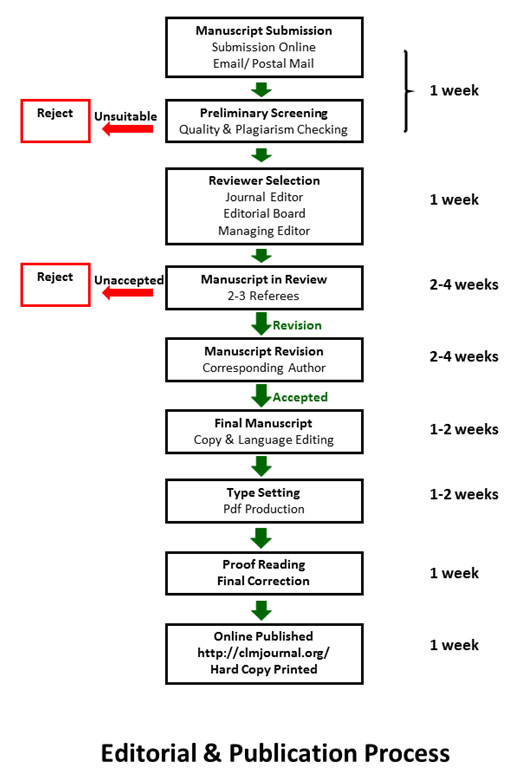Editorial Policy
Focus and Scope
Chulalongkorn Medical Journal aims to publish original peer-reviewed contributions related with various aspects in the biomedical and health sciences from experimental to clinical topics. Original research articles, short communications, review articles, case reports, and letter to editor are welcome.
The journal is supported by the Faculty of Medicine, Chulalongkorn University, who covers the cost of publication on behalf of the authors on acceptance of their article. Contemporary studies including basic research, clinical trials, studies of diagnostic accuracy, studies relating to behavioral, therapeutic, or epidemiological aspects of medicine, public health, environmental health, and health and social care are welcomed. We also welcome research from disciplines across the health sciences.
Section Policies
Open Submissions
Indexed
Peer Reviewed
Open Submissions
Indexed
Peer Reviewed
Open Submissions
Indexed
Peer Reviewed
Open Submissions
Indexed
Peer Reviewed
Open Submissions
Indexed
Peer Reviewed
Open Submissions
Indexed
Peer Reviewed
Open Submissions
Indexed
Peer Reviewed
Open Submissions
Indexed
Peer Reviewed
Open Submissions
Indexed
Peer Reviewed
Open Submissions
Indexed
Peer Reviewed
Open Submissions
Indexed
Peer Reviewed
Open Submissions
Indexed
Peer Reviewed
Open Submissions
Indexed
Peer Reviewed
Open Submissions
Indexed
Peer Reviewed
Peer Review Process
Peer review is the system used to assess the quality of a manuscript before it is published. Independent researchers in the relevant research area assess submitted manuscripts for originality, validity and significance to help editors determine whether the manuscript should be published in their journal. More details about the peer review process can be found here.
Chulalongkorn Medical Journal operates a double-blind peer review system, where both the reviewer and author identities are concealed from the reviewers, and vice versa, throughout the review process. It is the traditional model of peer review that many reviewers are comfortable with, and it facilitates an unbiased assessment of a manuscript.
Chulalongkorn Medical Journal is supported by an expert Editorial Board. All submitted manuscripts are evaluated by the Editor-in-Chief and appropriate manuscripts are then assigned to at least two reviewers for their comments. We make every effort to reach an initial decision within six weeks of submission. Based on the reviews, the Editor-in-Chief rejects, accepts or requests revisions of the manuscript.
Publication Frequency
All manuscripts submitted to the Chulalongkorn Medical Journal are first evaluated on the basis of scientific quality, originality, appropriateness, contribution to the field, and style. Suitable manuscripts are then subject to rigorous, fair, and rapid peer review.
Issues per year: Quarterly (10 - 15 articles per issue)
No.1 January - March
No.2 April - June
No.3 July - September
No.4 October - December
Open Access Policy
All articles published by the Chulalongkorn Medical Journal are made freely and permanently accessible online immediately upon publication, without subscription charges or registration barriers. As authors of articles published in the Chulalongkorn Medical Journal, they are the copyright holders of their own article and have granted to any third party, in advance and in perpetuity, the right to use, reproduce or disseminate their article. Our authors retain copyright of their work through a Creative Commons attribution license that clearly states how readers can copy, distribute, and use their attributed research, free of charge.
Conflict of Interest
The corresponding author of an article is asked to inform the Editor of the authors' potential conflicts of interest possibly influencing the research or interpretation of data. A potential conflict of interest should be disclosed in the cover letter even when the authors are confident that their judgments have not been influenced in preparing the manuscript. Such conflicts may include financial support or private connections to pharmaceutical companies, political pressure from interest groups, or academic problems. Disclosure form shall be same with the International Committee of Medical Journal Editors (ICMJE) Uniform Disclosure Form for Potential Conflicts of Interest (http://www.icmje.org/coi_disclosure.pdf). The Editor will decide whether the information on the conflict should be included in the published paper. In particular, all sources of funding for a study should be explicitly stated. The Chulalongkorn Medical Journal asks referees to let its Editor know of any conflict of interest before reviewing a particular manuscript.
Publication Process
Copyright & Licensing
The journal adopts CC BY-NC-ND license for its content. Users are free to:
- Share: Copy and redistribute the material in any medium or format.
- Attribution: You must give appropriate credit, provide a link to the license, and indicate if changes were made. You may do so in any reasonable manner, but not in any way that suggests the licensor endorses you or your use.
- Non Commercial: You may not use the material for commercial purposes.
- No Derivatives: If you remix, transform, or build upon the material, you may not distribute the modified material.
- No additional restrictions: You may not apply legal terms or technological measures that legally restrict others from doing anything the license permits.
- The non-commercial use of the article will be governed by the Creative Commons Attribution-NonCommercial-NoDerivs license as currently displayed on http://creativecommons.org/licenses/by-nc-nd/3.0/, except that sections 2 through 8 below will apply in this respect and prevail over all conflicting provisions of such license model. Without prejudice to the foregoing, the author hereby grants the Journal Owner the exclusive license for commercial use of the article (for U.S. government employees: to the extent transferable) according to section 2 below, and sections 4 through 9 below, throughout the world, in any form, in any language, for the full term of copyright, effective upon acceptance for publication.
- Under the Creative Commons Attribution-NonCommercial-NoDerivs license, the author(s) and users are free to share (copy, distribute and transmit the contribution) under the following conditions: 1. they must attribute the contribution in the manner specified by the author or licensor, 2. they may not use this contribution for commercial purposes, 3. they may not alter, transform, or build upon this work.

